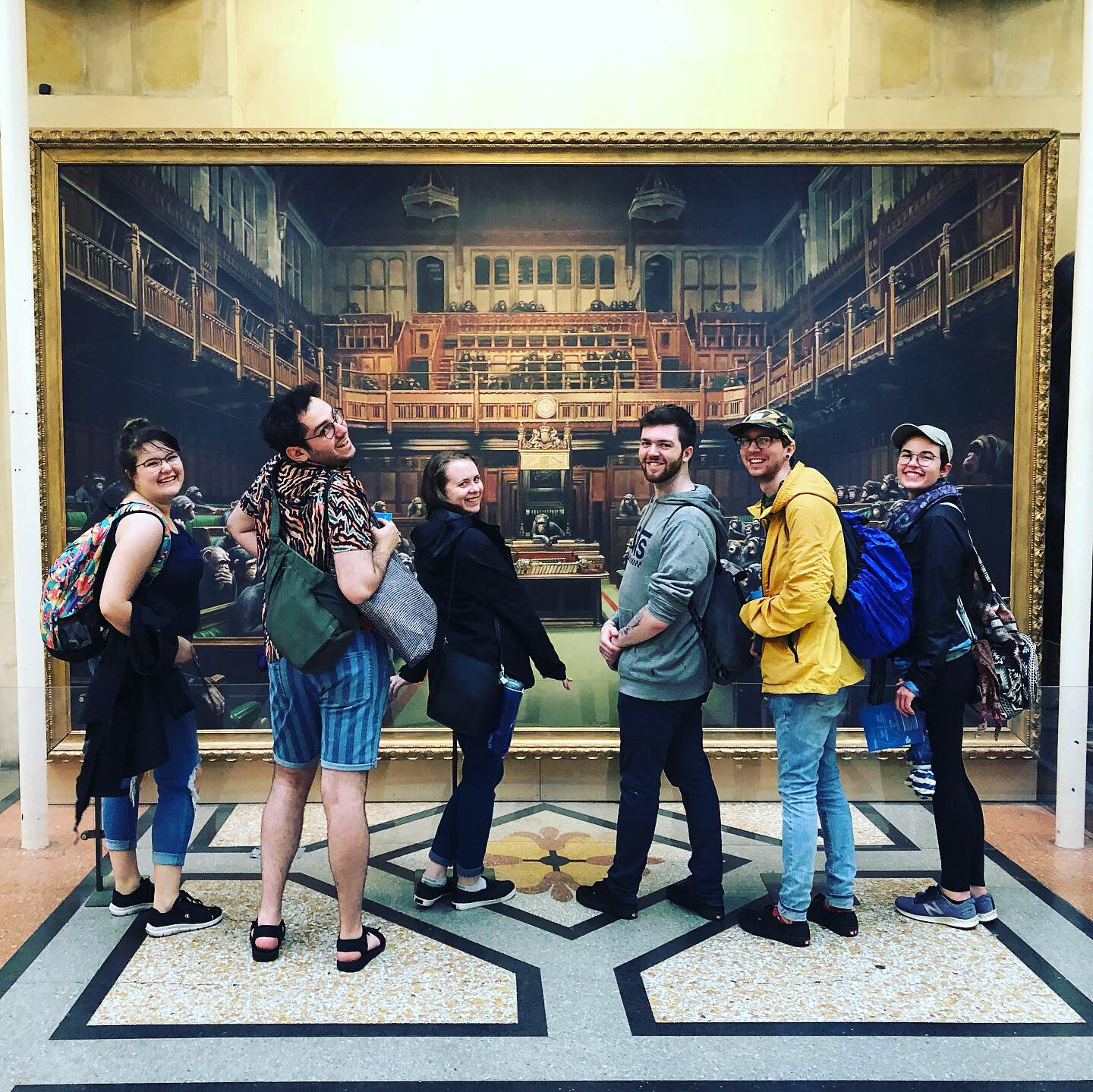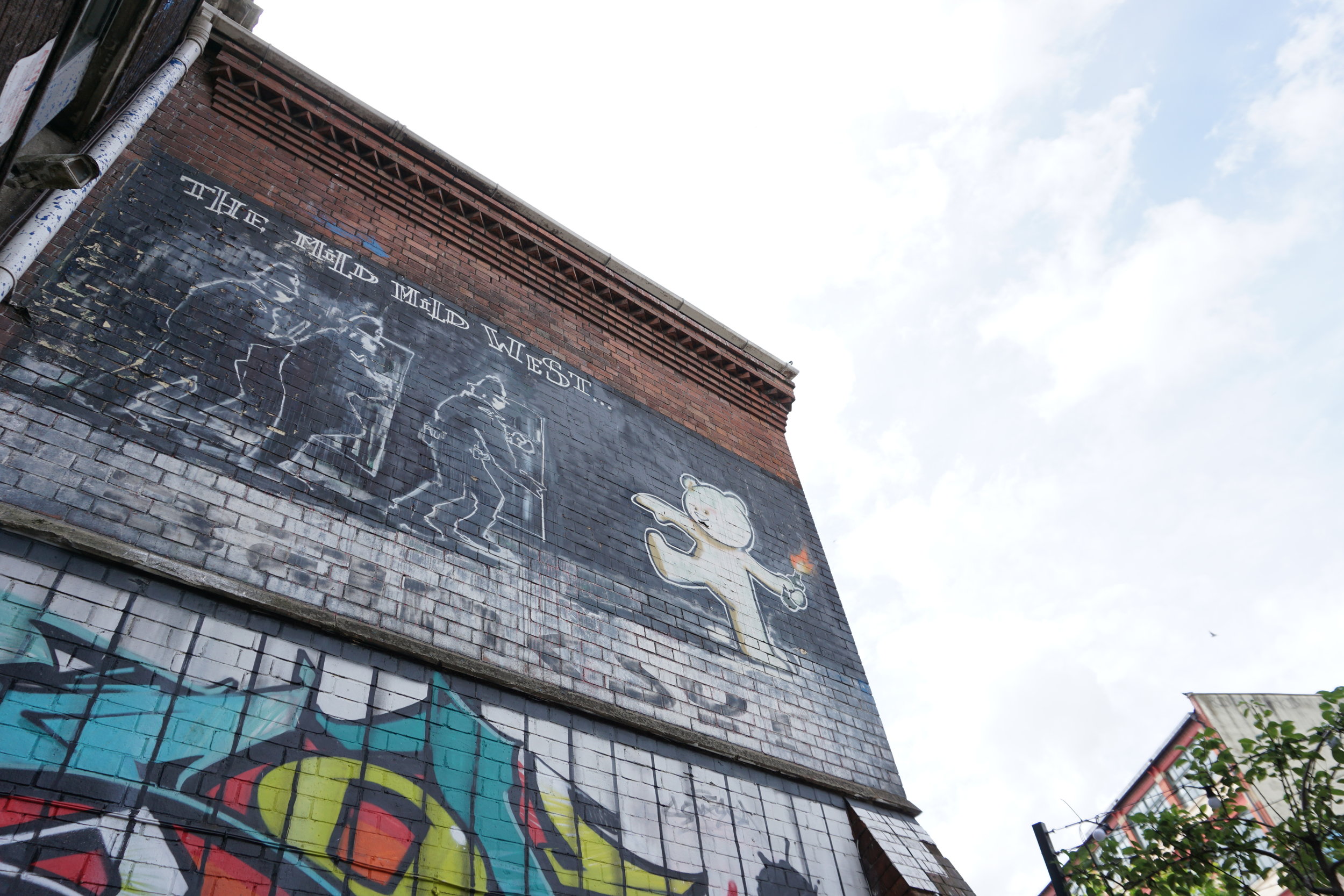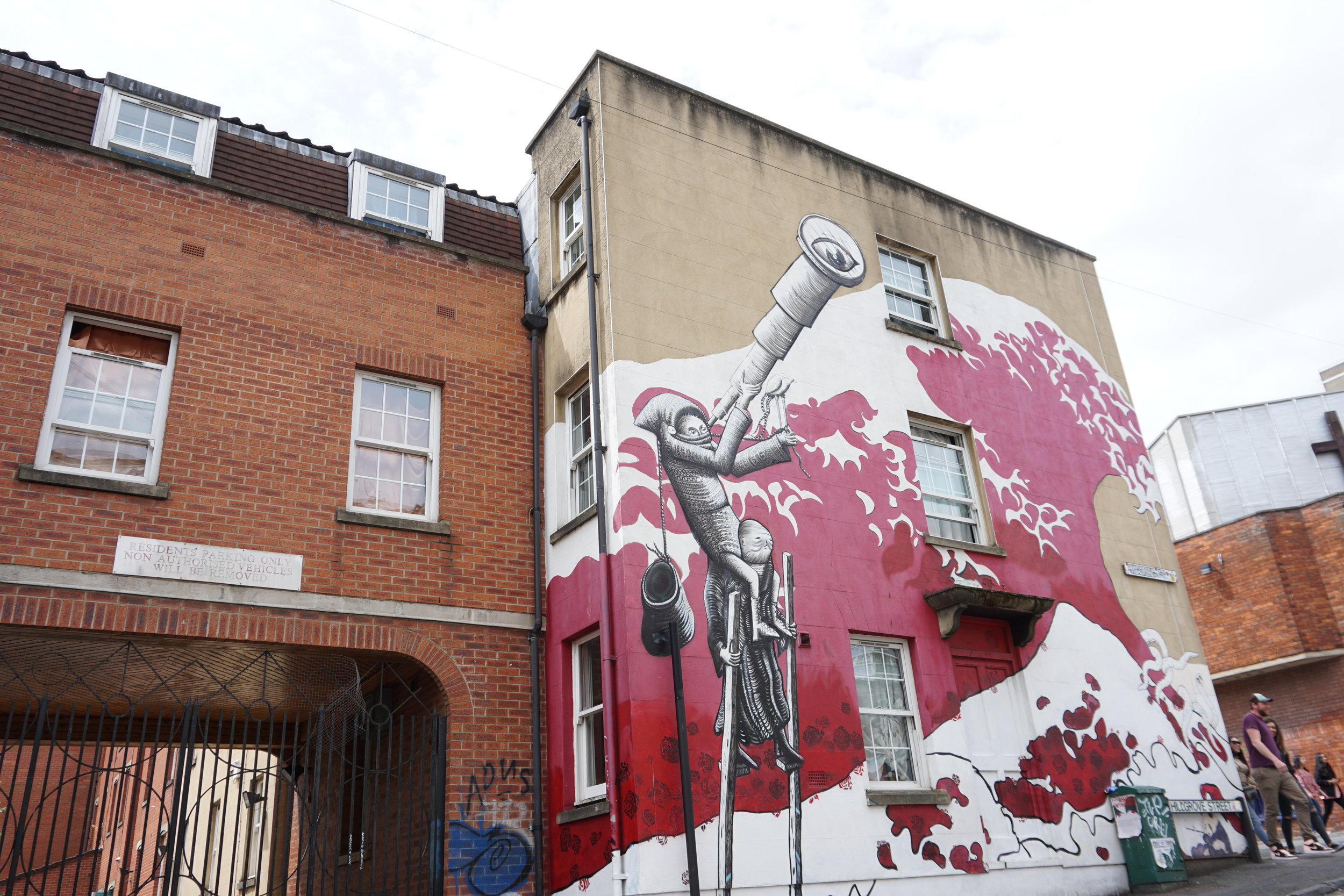Tell us a little bit about yourself—your background, major program of study, reasons for taking this trip, and anything else interesting you want to share (maybe something people might not know about you).
Steven, nearing the fourth year of his Fine Arts BFA program at KPU, is also doing the field school with his big brother Mark. Here they are pictured out front of our hostel while in London.
My name is Steven Robinson and I am a Fine Arts student that is slowly transitioning into my fourth year of the Bachelor of Fine Arts degree. I primarily use drawing and painting as my medium of choice, but I have always been interested in sculpture and three-dimensional work, because of my hands-on carpentry knowledge from previous education. I am in the process of bettering my knowledge of abstraction and implementing it into more traditional practices like landscape painting and seeing just how far I can push the limits of what makes a piece abstract as well as a landscape. Within the Bachelor of Fine Arts program there are many required art history courses to complete the degree that help understand the origins of painting and when I heard about the field school, I thought, what better way to take what I have learned in art history to analyze modern and contemporary works, as well as see to works that I have studied in person.
What has met or exceeded your expectations or surprised you about London (or Venice) so far?
I was fortunate to have a full week of experiencing London prior to writing this blog post and I can say that all my expectations have been fully satisfied and even additional surprises have made this week worth the long trip. I have been to Europe before, about five years ago, and thought that trip was fun, it wasn’t as fulfilling as I had hoped. But on this trip, I am extremely lucky that the people I am traveling with are more like-minded in the art field. No more being rushed out of galleries after one hour. The only thing I really wanted out of this trip was to see new art from new artists and to marvel in historical work in proximity. And I think that even after the first couple hours in the starting galleries satisfied my desires and now every other gallery or work is bonus
Steven, third from the right, enjoying a day in Bristol (with left to right, Victoria, Adam, Alison, Mark and Leah), part of which included taking in one of Banksy’s rare paintings at the Bristol Museum.
Give us some insight into your assigned artwork from the Tate Modern. After seeing the work in person in London (and any other related art from the same artist or art movement associated with the assigned work), what struck you most about it and/or how did the artwork’s form, content, and context shift for you when seeing it.
Steven seeing his assigned Tate Britain artist, Fiona Rae, for the first time.
My assigned artwork was Jack Whitten’s Epsilon Group II (1977) in the exhibition Painting with White at the Tate Modern. The piece is a black and white painting full of horizontal lines that are disrupted by a circle line and a singular diagonal line. The work was created with a tool that Whitten made himself, which any tool he makes he calls it a “developer”. He used the developer, in this case a long rake like stick covered with afro picks, to sweep the canvas once and scrap the paint with it. Prior to seeing the work in person, it seems to be a mass of horizontal lines and that’s about it. But in person, those line create an illusion like effect that gives the simple lines movement. As you stare the painting it seems to vibrate and give off an energy that it mesmerizing. The realisation that the lines were created simultaneously with one sweep is a thought after breaking the hypnotic visuals of the piece. The lines look so planned and thought out in person, yet they were created in a motion that probably only took a couple seconds.
How did you approach the creative task of responding to your assigned artists in studio? What were your challenges as an artist to be in dialogue with the artwork and artist? Would you do anything differently now that you have seen the work in person?
For my first piece, Untitled, I responded to Fiona Rae’s work Maybe you can live on the moon in the next century (2009) and I focused on the way she has a fluidity to the way she alters the paint as well as the solid tones within her gestures and spaces (see image below). What I wanted to create was a piece that focused on having fluidity in gestures and mixing of the medium contrast with solid tones and straight edges while still creating a balanced, yet busy composition. It was a challenge to be in conversation with Rae because I did not want to blatantly copy the way she would use the paint and I wanted to keep away from her pop culture references and focus on the painting just as a visual. There are parts that I would now like to go back and rework after seeing the piece in person, like not being afraid to block out any unsuccessful areas and rework them to help with the piece. And I would work bigger. The scale Rae worked at made a tremendous impact on it being a successful piece.
Steven’s first painting, Untitled, responding to assigned artist Fiona Rae at Tate Britain.
With my second piece, Overdeveloped Synthetic, I wanted to be in dialog with Jack Whitten’s work, Epsilon Group II, but specifically respond to the process behind how the work was created (see image below). I expanded on using the idea of using a tool that is different from the traditional tools like a paintbrush but instead of creating a tool, I found one. Using a found tool to create work is a big risk because I had absolutely no idea how it would turn out. And to keep the piece in conversation with Whitten’s, I decided to use the process of sweeping the tool across the canvas, or develop the work, twice. Whitten uses photography to describe his process to I expanded on how photos can be overexposed or overdeveloped. My work is overdeveloped in the process because of doing the second, unnecessary sweep. This was a big risk for me to do because by “overdeveloping” the piece, I risk losing a balance composition, even though I believe that my use of colours helps keep the piece unified. With this piece I honesty do not think I would change anything about it even after seeing Whitten’s work in person. I was looking at process and that is not always clear when viewing a piece. Though after seeing the piece at the Tate Modern, it helped me confirm that this new way of painting I have done is something that I will pursue in my practice.
Steven’s second painting Overdeveloped Synthetic responding to assigned artist Jack Whitten at the Tate Modern
Today’s activity was a free day to explore on your own. What were your impressions? What will you take away of the experiences of this day? What are the most memorable moments for you?
Today’s activity was located at the city of Bristol. We took a train across the island to go on a street art tour of the town which was significant because it is known that the famous artist Banksy is from there. My initial impressions before arriving were not high. I was not entirely interested in the street art scene and frankly went because it was a spontaneous decision by a group of us. But I was so wrong. It was by far the most memorable day full of so many experiences and connections with friends that I have had in a long time. The guide for the tour was an artist in the city and she knew a lot of the artist of the works that we were seeing that day. Her local knowledge of the art scene was an added bonus to hear and one thing that stuck with me was that having a political message in your work does not necessarily have to be a widely known topic. A lot of the works we looked at were referencing the local politics of the town, like Banksy painting on a fountain outside of the former city council building, the now city hall, which made me realise that an artist can talk about politics in a smaller scale if they want to.
The more memorable moments of the day trip were a bit more personal with our small group of seven. After our lunch, we were in a hurry to get back to the train, thinking we were going to be late for our only ride back, and the rain was a torrential downpour. We ended up hiding out under an entrance to a cathedral, but in the process, Adam’s paper pack crumpled within his hands and all his belongings scattered on the puddled pavement. But like a well-oiled machine, the group of us rushed to help. We all stuffed the fallen items into pockets trying to save everything and another person whipped out a new plastic bag like it was life or death. Within thirty seconds everything was into the bag minus the soaked bag on the ground. It was at that point that I realised the people who I have just recently became friends with on this trip are all kind human beings that truly care for one another. Under the protection from the rain by the church, we joked and laughed and enjoyed one another’s company and still getting to know each other more and more. Though these last couple days have felt jam pack with too many activities, time has gone by slow and I feel like I have known this group my entire life. The main take away from this trip will definitely be the friendships I have made, and even though experiencing such masterpieces and famous wall works in person will embed lasting visuals in my mind, these people will still be the grander take away from this trip.
The trip to Bristol was a day to remember. Pictured left to right in front of the oldest public Banksy work in Bristol:: Adam, Steven, Leah, Dorothy, Victoria, Alison, and Mark.










